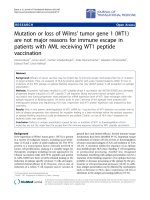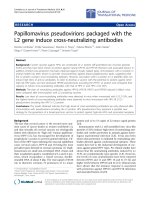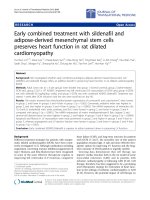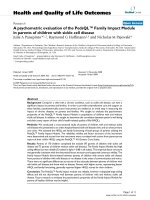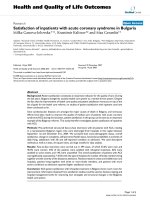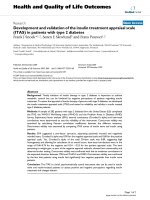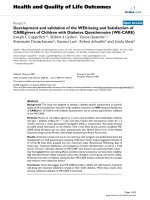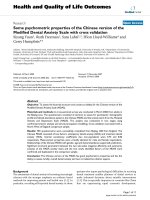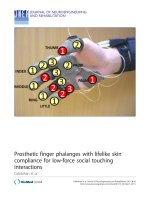Báo cáo hóa học: " Papillomavirus pseudovirions packaged with the L2 gene induce cross-neutralizing antibodies" pptx
Bạn đang xem bản rút gọn của tài liệu. Xem và tải ngay bản đầy đủ của tài liệu tại đây (448.02 KB, 9 trang )
RESEARC H Open Access
Papillomavirus pseudovirions packaged with the
L2 gene induce cross-neutralizing antibodies
Nicolas Combelas
1
, Emilie Saussereau
1
, Maxime JJ Fleury
1
, Tatiana Ribeiro
1,3
, Julien Gaitan
1
,
Diego F Duarte-Forero
1,2
, Pierre Coursaget
1*
, Antoine Touzé
1
Abstract
Background: Current vaccines against HPVs are constituted of L1 protein self-assembled into virus-like particles
(VLPs) and they have been shown to protect against natural HPV16 and HPV18 infections and associated les ions. In
addition, limited cross-protection has been observed against closely related types. Immunization with L2 protein in
animal models has been shown to provide cross-protection against distant papillomavirus types, suggesting that
the L2 protein contains cross-neutralizing epitopes. However, vaccination with L2 protein or L2 peptides does not
induce high titers of anti-L2 antibodies. In order to develop a vaccine with the potential to protect against other
high-risk HPV types, we have produced HPV58 pseudovirions encoding the HPV31 L2 protein and compared their
capacity to induce cross-neutralizing antibodies with that of HPV L1 and HPV L1/L2 VLPs.
Methods: The titers of neutralizing antibodies against HPV16, HPV18, HPV31 and HPV58 induced in Balb/c mice
were compared after immunization with L2-containing vaccines.
Results: Low titers of cross-neutralizing antibodies were detected in mice when immunized with L1/L2 VLPs, and
the highest levels of cross-neutralizing antibodies were observed in mice immunized with HPV 58 L1/L2
pseudovirions encoding the HPV 31 L2 protein.
Conclusions: The results obtained indicate that high levels of cross-neutralizing antibodies are only observed after
immunization with pseudovirions encoding the L2 protein. HPV pseudovirions thus represent a possible new
strategy for the generation of a broad-spectrum vaccine to protect against high-risk HPVs and associ ated neoplasia.
Background
The fact that cervical cancer is the second most com-
mon cause of cancer deaths in women worldwid e [1],
and that virtually all cervical cancers are e tiologically
linked with infection by “ high risk” human papilloma-
virus (HPV) [2], has encouraged the development of
prophylactic vaccines to prevent genital infection. Fif-
teen of the HPV types infecting the m ucosal epithelium
cause cervical cancer, HPV16 and 18 being the most
prevalent types detected in cervical carcinoma [1]. Papil-
lomaviruses are small non-enveloped DNA viruses and
their icosahedral capsid is constituted of L1 and L2 pro-
teins, which encapsidate a closed circular, double-
stranded DNA of about 8 kbp. The viral capsid of 50-60
nm in diameter con tains 72 pentamers of L1 major
protein and 12 to 72 copies of L2 minor capsid protein
[3,4].
Immunization with L1 self-assembled into virus-like
particles (VLPs) induces high tite rs of neutr alizing anti-
bod ies and confers protection in animals against homo-
logous experimental infection [5,6]. It has also been
shown that protection is mediated by neutralizing anti-
bodies directed against conformational epitopes. These
results have led to the industrial development of vac-
cines against genital HPV types. Pre-clinical studies have
shown that the neutralizing antibodies induced by L1
VLPs are predominantly type-specific [7,8]. However,
low levels of cross-neutralization have been reported
between H PV6 and 11 and HPV 16 and 31 [9-12] and
higher levels between HPV18 and 45 [13]. Clinical trials
have shown that the immune response is associated
with protection against HPV16 and HPV18 infections
and associated lesions [14,15].
* Correspondence:
1
Inserm U618 “Protéases et vectorisation pulmonaires”, Tours; University
François Rabelais, Tours, France and IFR 136 “Agents Transmissibles et
Infectiologie”, Tours, France
Combelas et al. Journal of Translational Medicine 2010, 8:28
/>© 2010 Combelas et al; licensee BioMed Central Ltd. This is an Open Access article distributed under the terms of the Creative
Commons Attribution License ( which permits unrestricted use, distribution, and
reproduction in any me dium, pr ovided the original work is properly cited.
Current HPV vaccines containing L1 VLPs promote
the generation of a strong, mainly type-specific, neutra-
lizing antib ody response. Clinical trials with HPV16 and
18 vaccines have also reveal ed that cross-protection
against HPV types is limited to closely related types.
Protection against HPV31 lesions was clearly establi shed
for both vaccines a nd protection against HPV45 lesions
for only one vaccine [15,16]. As the licensed HPV vac-
cines target only two of the 15 high-risk HPV, one strat-
egy is to combine many t ypes of L1 VLPs to prevent
infection against multiple high-risktypes.Toaddress
this issue, a multivalent VLP vaccine is currently under
clinical trial [17]. However, the inclusion of numerous
VLP t ypes complicates vaccine development and would
increase the risk of a ntigenic competition that could
result in lower protective efficacy and/or affect long last-
ing protection against certain HPV types.
The m inor capsid L2 protein has emerged as another
candidate prophylactic vaccine, sin ce immunization with
L2 in animal models of papillomavir us infectio n induces
cross-neutralizing antibodies that ar e able to mediate
broader protection than L1 VLPs [7,18-24]. Preclinical
and clinical findings [25-27] have confirmed that L2 vac-
cines induce broad-spectrum cross-neutralizing antibo-
dies. However, L2 protein and L2 peptides are less
immunogenic than L1 VLPs, and it has been reported
that the incorporation of the L2 protein into L1 VLPs
does not increase the anti-L2 response due to the
immunodominance of L1 [23]. This s uggests that new
vaccine strategies have to be investigated if such an L2-
based vaccine is to be effective.
Although most investigations concerning VLPs have
dealt with vaccine development, it has also been demon-
strated that HPV VLPs can be used to generate pseudo-
virions (PsV) by packaging unrelated plasmids within
the VLPs, and they thus represent a valuable gene deliv-
ery system that could be used to induce an immune
response against the packaged de novo synthesized
transgene product [28,29].
The aims of this st udy were to investigate the poss ibi-
lity of generating an HPV vaccine by packaging a plas-
mid encoding the HPV 31 L2 protein within HPV58 L1/
L2 PsV (PsV58-31L2). The L2-pseudovirion vaccination
strategy aims to induce high-titers of conformation-
dependent antibodies to L1 similar to those observed
with monovalent HPV VLP L1 vaccines and to induce
de novo L2 expression for augmented immunogenicity
to L2 protei n in order to cross-neutralize multiple HPV
types [30].
Materials and methods
Antibodies and Cell lines
CamVir-1 monoclonal antibody (MAb) (BD Biosciences,
Le Pont de Claix, France) binds to a linear epitope
which has been mapped between amino acids 203 to
209 of the HPV-16 L1 protein [31]. Rabbit anti-HPV16
L2 immune serum was kindly provided by Richard
Roden. COS- 7 cells (Africa n green monkey kidney cells,
ATCC CRL-1651) were grown in Dulbecco’ s modified
Eagle’s Medium (Invitrogen, Illkirch, France) supple-
mented with 10% heat- inactivated fet al calf s erum
(FCS), 100 IU/ml penicillin, and 100 μg/ml streptomycin
and 1 mM sodium pyruvate. The 293FT cell line (Invi-
trogen) is a fast growing variant of the 293 ce ll line that
stably expresses SV40 T Ag and the neomycin resistance
gene from pCMVPORT6AT.neo plasmid. 293FT cells
weregrowninDulbecco’ s modified Eagle’sMedium,
supplemented as above, plus 1% non-essential amino
acids and 500 μg/ml G418 (Invitrogen). Cell lines were
grown at 37°C in a humidified atmosphere with 5% CO
2
.
Production of HPV VLP vaccines
HPV31L1andHPV31L1/L2VLPswereproducedand
purified from Sf21 insect cells infected with recombinant
baculoviruses encoding both L1 and L2 proteins as pre-
viously described [32,33]. HPV58 L1/L2 PsV were
obtained using a cellular system with codon-modified
HPV capsid genes [34]. Briefly, HPV 58 L1 and L2
genes were designed to contain the most frequently
used codons found in h ighly expressed ge nes in Homo
sapiens (FN178626 and FN178627, respectively). L1 and
L2 genes were cloned into the mammalian bicistronic
expression vector, pIRES (BDBiosciences, Clontech).
The HPV58 L1 gene was cloned between the NheIand
EcoRI restriction sites of MCS A downstream from the
CMV IE pro moter. The HPV58 L2 ge ne was subse-
quently cloned between the XbaIandNotI restriction
sitesofMCSBofpIRES-HPV58L1togeneratepIRES-
HPV58 L1/L2 plasmids of 9.1 kbp. Plasmid s of this size
were previously shown not to be packaged when form-
ing PsV in a cellular system [35]. DNA plasmid pIRES
L2 ΔNLS (7.4 kbp) used for the production of PsV was
prepared by classical phenol/chloroform DNA prepara-
tion. This plasmid contains the DNA sequence encoding
amino acids 12 to 442 of the HPV31 L2 between the
XbaIandNotI restriction sites. This sequence was PCR-
amplified from a plasmid containing a Homo sapiens
codon-adapted full length HPV31 L2 gene [36]. This
deleted mutant of the L2 gene was selected to reduce
the amount of HPV31 L2 pro tein exported to the
nucleus and to prevent its incorporation into the
HPV58 PsV structure. For the generation of HPV58 PsV
in 293FT cells, cells were transfected with 0.5 μgDNA,
0.25 μg pIRES HPV31 L2 ΔNLS or 0.25 μg pCMV-GFP,
0.25 μg of pIRES-H PV58 L1/L2 and 1 μlFugene6
(Roche) per cm
2
of the culture area. Cells were har-
vested two days post-transfection, and PsV were purified
as previously described [36] and stored at -80°C until
Combelas et al. Journal of Translational Medicine 2010, 8:28
/>Page 2 of 9
use. Pseudovirions were quantified by Western blotting
usingCamVir-1antibodybycomparisonwithknown
concentrations of HPV58 L1/L2 VLPs. Pseudovirions
containing HEV ORF2
108-660
(PsV31-HEV) were pro-
duced using the same proce dure as described for HPV
58 PsV using previously des cribed pIRES-HPV31 L1/L2
[36] and pcDNA3 HEV ORF2
108-660
, plasmids [29].
Immunization protocol
Six-week-old female BALB/c mice (CERJ Janvier, Le
Genest St Isle, France) were intramuscul arly immunized
with the different vaccine preparations. Mice from
group 1 received saline, mice from groups 2 and 3
received 1 and 10 μg of pIRES-HPV31 L2ΔNLS plasmid
(DNA L2), respectively (Table 1). Mice from groups 4
and 5 received HPV31 L1 and HPV31 L1/L2 VLPs (31
L1L2 VLPs), respectively. Mice from group 6 received
10 μg of HPV31 L1/L2 PsV containing HEV ORF2
108-
660
expression plasmid (PsV31-HEV) [29]. Mice from
groups 7 and 8 rec eived HPV58 L1 /L2 PsV contain ing
GFP expression plasmid (PsV58-GFP) and HPV58 PsV
packaged with HPV31L2ΔNLS plasmid (PsV58-31L2),
respectively. In order to eliminate variations in the pseu-
dovirion DNA content, the preparations used were from
the same batch. Mice were immunized a t days 0, 7 and
21. Two weeks after the last injection, serum samples
were collected and stored at -20°C. All animal proce-
dures were performed according to approved protocols
and in accordance with the recommendations for the
proper use and care of laboratory animals, and experi-
ments were approved b y the regional animal ethics
commmittee (CREEA Centre-Limousin).
Expression of L2SA and detection of anti- L2 antibodies
L2 protein was expressed in i nsect cells as a fusion pro-
tein. In o rder to purify the L2 protein from insect cells,
the Streptactin (SA) coding sequence [37] including
upstream (BamHI and SalI) and downstream (HindIII)
restriction sites was synthesized by Geneart (Regensburg,
Germany) using an adapted codon usage for expression
in Spodoptera frugiperda.TheSAsequencewascloned
between SalIandHindIII sites of the pFastBacDual
expression vector (Invitrogen) in order to obtain the
pFastBacDual SA plasmid. The HPV16 L2 ORF was then
fused at the 5’ end of the SA ORF. For this purpose, the
HPV16 L2ΔNLS ORF (amino acids 12 to 442) was ampli-
fied by PCR from a plasmid containing a Homo sapiens
codon adapted version of the wild type L2 gene
(FN297862) using HPV16 L2 F (CC
GGATCCGCCAC-
CATG GCCAGCGCCACCCAGCTG) and HPV16 L2Δ R
(
GTCGACCATGTAGTAGCTGGGGTGCAGGATG). A
forward primer w as designed to introduce a BamHI site,
and a Kozak sequence upstream from the start codon
and the reverse primer contained a SalI restriction site.
The PCR product w as then cloned by TA cloning into
the pCR2.1 vector (Invitrogen). Both pCR2.1- 16 L2ΔNLS
and pFastBacDual SA plasmids were submitted to restric-
tion with BamHI and SalI, and the L2 gene was fused to
the Streptactin gene in order to generate the pFastBac-
Dual-16 L2 ΔNLS (pFBD-L2SA).
A recombinant baculovirus encoding L2SA was gener-
ated using the Bac-to-Bac system (Invitrogen) according
to the manufacturer ’s recommendations. Sf21 insect cells
weregrownat27°CinSF900IImediumsupplemented
with penicillin, streptomycin and amphotericin B (Invitro-
gen ). Cells were infected at a m.o.i. of ten and grown for
four days. Cells were scraped off, centrifuged at 30 0 × g
and then resuspended in PBS 1× containing 0.5% Nonidet
P40 and an anti-protease cocktail (Roche, Meylan, France)
and incubated on ice for 30 min. The lysate was centri-
fuged at 4°C for 10 min at 12,000 × g. The pellet, repre-
senting the nuclear fraction, was subjected to sonification
(3 × 15 s bursts, Vibracell, Fischer Sc ientific, France).
L2SA protein was purified by affinity on immobilized imi-
nobiotin according to the manufacturer’ s instructions
(Pierce, Ozyme, Montigny le Bretonneux, France).
Table 1 Composition of the vaccines preparations used and anti-HPV16, HPV18, HPV31 and HPV58 neutralizing
antibody titers in mice immunized with the different vaccines.
Group
N°
Proteins Gene Neutralizing titers
Name L1 L2 HPV16 HPV18 HPV31 HPV58
1 Saline - - - - - - -
2 DNA L2 (1 μg) - - HPV31 L2Δ
3 DNA L2 (10 μg) - - HPV31 L2Δ
4 31 L1 VLPs 31 - - - - 2,800 -
5 31 L1L2 VLPs 31 31 - - - 3,400 65
6 PsV31-HEV 31 31 HEV ORF2 - - 5,198 54
7 PsV58-GFP 58 58 GFP - - 50 4,650
8 PsV58-31L2 58 58 HPV31 L2Δ 60 400 733 5,382
Cross-neutralizing titers are in bold-faced characters.
Combelas et al. Journal of Translational Medicine 2010, 8:28
/>Page 3 of 9
Two hundred nanograms of L2SA were distributed in
half of the wells of a 96-well plate (Maxisorp, Nunc,
ATGC, Marne-la-Vallée, France) and incubated at 4°C
overnight. After two washes with PBS-Tween (0.1%), the
wells were saturated with PBS supplemented with 1%
FCS for 1 h at 37°C. Duplicate wells (one test and o ne
control) were incubated with two-fold dilutions (starting
at 1:25) of mice sera in dilution buffer (PBS 5×, 1%
Tween, 10% FCS) for 1 h at 45°C. After four washes,
peroxidase-conjugated goat anti-mouse IgG (Fc-spec ific)
(Sigma Aldrich) diluted 1:1,000 in PBS - Tween (1%) -
FCS (10%) was added to the wells and incubated fo r 1 h
at 45°C. After four washes, 0.4 mg/ml o-phenylene-dia-
mine and 0.03% hydrogen peroxide in 25 mM sodium
citrate and 50 mM Na
2
HPO
4
were added. After 30 min,
the reaction was stopped with H
2
SO
4
4N and optical
density (OD) was re ad at 492 nm. For data analysis, OD
values obtained in the absence of L2SA were subtracted
from OD values of test antigens. A result was consid-
ered positive when the difference in OD between test
and control wells was greater than 0.2. Individual titers
represented the reciprocal of the last dilution giving an
OD difference greater than 0.2. Values for individual
mice were the means of duplicates. Geometric mean
titers (GMTs) were calculated for each group. Animals
without detectable antibody titers (< 25) were assigned a
titer of 1 for calculation of GMTs.
Detection of anti-HPV neutralizing antibodies
Neutralization assays were performed by inhibition of
pseudoinfection of COS-7 cells by pseudovirions con-
taining the pGL3-luc plasmid (Promega, Charbonnières-
les-Bains, France). HPV16and18PsVwereproduced
by the previously published disassembly-reas sembly
method [38] with some modifications [39]. L1/L2 VLPs
(100 μg) were incubated in 50 mM Tris-HCl buff er (pH
7.5) containing 20 mM DTT and 1 mM EGTA for
30 min at ro om temperature. At this stage, pGL3-luc
(10 μg) was added to the disrupted VLPs. The prepara-
tion was then diluted with increasing concentrations of
CaCl
2
(up to a final concentration of 5 mM) in the pre-
sence of 10 nM ZnCl
2
. Pseudovirions were then dialyzed
overnight against PBS 1× and stored at 4°C before use.
HPV31 and 58 PsV were obtained using a cellular sys-
tem with codon-modified HPV capsid genes and pGL3-
luc plasmid as described above for HPV58 pseudovirons
encoding L2.
COS-7 cells (10
4
/well) were seeded in 96-well plates
(TPP, ATGC). After 24 h incubation at 37°C, cells were
washed twice before addition of pseudovirion/sera mix-
ture. The amount of pseudovirions was adjusted to
obtain a relative luciferase activity of 0.2 RLU (Relative
Light Unit) (final dilutions in test wells: 1:500 for
HPV16, 1:50 for HPV 18, 1:800 for HPV31, and
1:10,000 for HPV 58). Mock transduced COS-7 cells
exhibit 0.00001 RLU (Luminoskan Ascent, Thermo
scientifi c, Courtaboeuf, France). Fifty μl of diluted pseu-
dovirions were mixed with 50 μl of mice sera diluted by
two-fold dilution in incomplete DMEM from 1:12.5 to
1:25,600 in order to obtain final serum dilutions of 1:25
to 1:51,200. After 1 h inc ubation at 37°C, the mixture
was added to the wells and plates were incubated 3 h at
37°C. Then 100 μlofcompleteDMEMwereadded,and
the luciferase gene expression was measured after incu-
bation for 48 h at 37°C (Firefly luciferase 1-step assay
kit, Fluoprobes, Interchim,Montluçon,France).The
results were expressed as the percentage of inhibition of
luciferase activity [36]. The data presented are the
means of 2 to 3 determinations performed in duplicate.
Neutralization titers were defined as the reciprocal of
the highest dilution of mice sera that induced at least
50% reduction in luciferase activity. Geometric mean
titers were calculated for each group. Animals without
detectable neutralizing antibodies were assigned a titer
of 1 for the calculation of GMTs.
Statistical analysis
Geometric mean titers were compared to evaluate
ELISA and neutralizing responses. Group results (10
animals per group) were compared by Student t test
using XLStat software (Addinsoft, Paris, France).
Results
Production of HPV58 pseudovirions
In order to generate HPV58 PsV, 293FT cells were
transfected simultaneously with the pIRES-HPV58 L1/
L2 plasmid encoding the structural proteins of HPV58
and the pGL3 plasmid e ncoding luciferase. Three days
post-transfection, the nuclear fraction of 293FT cells
was analysed by Western blotting. HPV58 L1 and L2
proteins were efficiently expressed (Fig. 1A). Then the
ability of PsV58-31L2 to transduce the HPV31 L2 ΔNLS
gene was investigated by pseudo-infection of COS-7
cells. Western Blot analysis of L2 protein expression
indicated that L2 was detected two days after transduc-
tion (Fig. 1B). In order to rule out the possibility that L2
detected in COS-7 cells was due to the presence of the
HPV58 L2 contained in the pseudovirion structure,
COS-7 cells were transduced with similar PsV packaged
with the GFP gene. The presence of L2 was n ot evi-
denced in the latter condition (Fig. 1B).
After purification, samples of HPV58 PsV stock were
titered by measuring their end-point luciferase gene
transduction capacities on Cos-7 cells, and compared
with HPV31 PsV obtained in the same cellular system
and experimental conditio ns. Using endpoint titers with
a cut-off based on the background luminesce nce of
mock transduced Cos-7 cells, HPV 58 L1/L2 PsV were
Combelas et al. Journal of Translational Medicine 2010, 8:28
/>Page 4 of 9
shown to be 20 times more efficien t than HPV31 L1/L2
(data not shown). In view of this result, HPV58 L1/L2
PsV were selected t o develop pseudovirion-based
immunization.
Anti-HPV16-L2 immune response in mice immunized with
heterologous VLPs and pseudovirions
Anti-HPV16 L2 antibodies were not detected in non-
immunized mice (group 1) . Anti-L2 antibodies were not
detected in mice immunized with HPV31 L1 VLPs
(group 4), but were detected in all mice immunized
with the LIL2 VLPs (group 5), with a GMT of 1,100.
Anti-L2 antibodies w ere detected at similar levels in
mice immunized with control PsV (groups 6 and 7),
with GMTs of 855 and 1,212 (p = 0.459). By comparison
with these control pseudovirions, the anti-L2 GMT
(2,600) was higher in mice immunized with PsV58-31L2
(p = 0.001 and p = 0.101, respectively).
Induction of cross-neutralizing antibodies
Homologous HPV31 n eutralizing antibodies were
detected in mice immunized with HPV31 L1 or HPV31
L1L2 VLPs and HPV31 HEV PsV (groups 4 , 5 and 6),
with GMTs of 2,800 ± 2360, 3,400 ± 460 and 5,198 ±
900, respectively (GMT ± SEM). Low titers of HPV58
neutralizing antibodies were only observed in mice
receiving HPV31 L1L2 VLPs (group 5) and H PV31 PsV
containing the HEV ORF2 irrelevant gene (group 6). No
neutralizing antibodies against HPV16 and HPV18 were
detected in any of the mice from groups 4 to 6 receiving
HPV31 VLP vaccine preparations (Fig. 2).
High levels of homologous neutralizing antibodies
were detected in mice immunized with HPV58 PsV
(groups 7 and 8), with GMTs of 4,650 ± 980 and 5,382
± 2240, respectively. Low levels of neutralizin g antibo-
dies to HPV31 (GMT = 50 ± 315) were d etected in
mice immunized with PsV58-GFP, and a dramatic
increase in anti-HPV31 neutralizing antibodies (with a
GMT of 7 33 ± 190) was observed in mice immunized
with PsV58-31L2. Moreover, neutralizing antibodies
against H PV16 and HPV18 were only detected in mice
immunized with the PsV58-31L2, with GMTs of 60 and
400, respectively (Table 1).
Discussion
Since no differences in antibody titers or in protection
were observed in animal studies [40] when immuniza-
tion with L1 and L1/L2 VLPs were compared, it was
generally believed that there was insufficient reason to
introduce L2 protein into the c omposition of VLPs. In
addition, L2 protein assembled in L1 VLPs is weakly
immunogenic due to the immunodominance of L1 [23].
However, our findings suggested that eve n in the
absence of adjuvant cross-neutralizing antibodies could
be obtained by incorporating L2 in the composition of
the VLPs (group 5) or pseudovirions encoding irrelevant
genes (groups 6-7) compared to L1 VLPs (group 4),
despite the low anti-L2 immune response (GMT 855 to
1212). Anti-L2 antibody titers are generally several
orders of magnitude lower than the anti-L1 titers
obtained with VLP vaccines. However, even low anti-L2
antibody levels have been shown to be sufficient for pro-
tection [22,26], this being in part explained by the slow
uptake kinetics into cells reported for HPVs [41]. In
Figure 1 Western blot. A/Analysis by Western blotting of the
HPV58 pseudovirion capsid proteins. L1 was detected using the
CamVir-1 monoclonal anti body (lane 1). L2 was detected using
polyclonal anti-HPV16 L2 rabbit antiserum (lane 2). B/Detection of
L2 protein by Western blotting using polyclonal anti-HPV16 L2
rabbit antiserum.Cos-7 cells were transduced with HPV58
pseudovirions encoding GFP (lane 1) or with HPV58 pseudovirion
encoding HPV31 L2 (lane 2).
Combelas et al. Journal of Translational Medicine 2010, 8:28
/>Page 5 of 9
400
1,600
6,400
25
100
25,600
Anti-HPV58 neutralization titers
31 L1L2
VLPs
PsV31
HEV
PsV58
GFP
PsV58
31L2
31 L1
VLPs
25,600
25
400
1,600
100
6,400
p< 0.001
Anti-HPV18 neutralization titers
1,600
6,400
25
400
100
25,600
p< 0.001
Anti-HPV31 neutralization titers
25,600
25
400
1,600
100
6,400
Anti-HPV16 neutralization titers
Figure 2 Detection of HPV16, HPV18, HPV31 and HPV58 neutralizing antibodies. The individual mouse neutralizing titers are the means of
the last reciprocal dilution providing more than 50% inhibition of luciferase expression. Animals without detectable antibody titers (< 25, dotted
line) were assigned a titer of 1 for calculation of GMTs (horizontal bars).
Combelas et al. Journal of Translational Medicine 2010, 8:28
/>Page 6 of 9
addition, we evaluated the immune response obtained in
mice immunized with 10 μgofL2SAfusionprotein
without adjuvant. In these mice, L2 protein induced
only a weak anti-HPV16 L2 response (GMT = 348), and
a weak homologous neutralizing response in 3 out of 10
mice. Cross-neutralizing antibodies to HPV 18, 31 and
58 were not detected. These results differ from pre-
viously published results [23] in which broad spect rum
cross-neutralization was observed in rabbits immunized
with higher doses of L2 protein (100 μg) in combination
with Freund’s adjuvant. The induction of higher levels
of cross-neutralization of HPV 31 L1/L2 VLPs com-
pared to HPV 31 L1 VLPs suggested that, due to the
potential antigenic competitions, HPV L1/L2 VLP of a
limited number of genotypes would be a much easier
solution compared to the technical complexity of gener -
ating a multivalent vaccine [42].
Since HPV16 and HPV18 PsV and HPV31 and HPV58
PsV were produced in different ways, with different
infection titers and particle-to-infectivity ratios, the
results obtained might have been affected by the fact
that the different neutralization assays might not have
the same sensitivity. The HPV16 neutralization assay
performed with PsV produced by the dissociation reas-
sociation method [39] appeared to be less sensitive than
HPV 31 and 58 neutralization assays performed with
PsV obtained in mammalian cells. We theref ore investi-
gated the relative sensitivity of the assays by comparing
the ratio between homologous neutralizing titers and
homologous ELISA titers for each type. These ratios
were 0.22, 0.93, and 0.71 for HPV 16, 31, 58, respec-
tively, indicating t hat the HPV16 neutralizing assay is
3.5 less sensitiv e than the HPV58 neutralizing assay and
4.2 less sensitive than the HPV31 neutralizing assay.
These differences in sensiti vity may explain why HPV16
neutralizing antibodies were not detected in mice immu-
nized with HPV31 (groups 5 and 6) for which HPV58
neutralizing titers of 65 and 54 were observed. This also
explains the low HPV16 neutralizing titers observed in
mice immunized with PsV58-31L2 (group 8) compared
to those of HPV18 and 31. Although the intensity of
cross-neutralizing responses was not directly comparable
to other studies, our findings clearly indicate that the
highest levels of cross-neutralizing antibodies were
observedwithPsVencodingtheHPV31L2protein.
However, the ratio of neutralizing antibody titers against
heterologous types to those against homologous types
represented 1 % in mice immunized with L1L2 VLPs or
control PsV, whereas a ratio of around 10% was
observed in mice immunized with PsV encoding the
HPV31 L2 protein. The latter ratio is in agreement with
those reported by Gambhira et al [25] and Alphs et al
[26] using L2 peptides and potent adjuvants.
The de novo synthesis of HPV 31 L2 from the L2 gene
packaged in HPV58 PsV is likely to have a critical role
in the induction of cross-neu tralization, since neutraliz-
ing antibodies against H PV16 and a more genetically
distant type from the alpha-7 clade (HPV1 8) were only
detected in mice immunized with the HPV58 PsV
encoding L2 (group 8) and not in mice immunized with
HPV58 PsV encod ing GFP ( group 7). In addition, the
higher anti-H PV31 neutralizing titers observed in mice
from group 8 (GMT = 733) was likely to have been d ue
to the de no vo production of L2 protein due to the
transduction of the HPV31 L2 plasmid, since the mice
from group 7 immunized with PsV GFP presented a
GMT of only 50 (p < 0.001). This was correlated to the
fact that the highest anti-HPV16 L2 antibody titers
observed in mice from group 8 were associated with the
highest and broadest detection of cross-neutralizing
antibodies.
As the HPV31 L2 protein encoded by the pIRES
HPV31 L2 ΔNLS plasmid may be part of the HPV 58
PsV structure, t his HPV31 L2 might have a role in the
cross-neutralizing response. The HPV 31 L2 protein
without N- and C-terminus NLS sequences was
expected not to reac h the nucleus where pseudovirions
are assembled. In fact, HPV31 L2 protein was still
detected in the nuclear fraction of producer cells (data
not shown), in agreement with previous reports by [43].
Moreover, it was not possible to differentiate between
the presence of HPV31 and HPV58 L2 in the capsid.
However, the deleted HPV31 L2 should be excluded
from the pseudovirion capsid since the C-terminus N LS
has been shown to be necessary for in vivo interaction
between L2 and L1 in the BPV-1 model [44].
It’s possible that the third injection of pseudovirions
was not necessary in mice immunized with PsV58- 31L2
since it could be expected that the first two injections
would have induced anti-HPV58 neutral izing antibodies
that would block the expression of the HPV31 L2 pro-
tein. In order to inves tigate this, sera were obtained one
week after the second inje ction from these mice and
then tested for the presence of neutralizing antibodies
against HPV16 and 31. Before the booster, anti-HPV31
neutralizing antibodies were detected at a G MT of 77,
and this rose to 733 after the booster dose. HPV16 neu-
tralizing antibodies were not detected after the second
dose but reached a GMT of 50 after the booster. This
booster effect was probably due to a response to the de
novo expressed HPV31 L2 protein and was not a boos-
ter effect due to the immune response to L1 and L2
proteins from the pseudovirion capsid, since a cross-
neutralizing antibody titerofonly50wasobservedin
mice immunized with PsV58-GFP in comparison with a
GMT of 733 in mice immunized with PsV58-31L2.
Combelas et al. Journal of Translational Medicine 2010, 8:28
/>Page 7 of 9
Conclusions
HPV58 PsV encoding the HPV31 L2 protein were pro-
duced in order to develop a vaccine with the potential
to protect against a broad spec trum of high-risk HPV
types, and their capacity to induce cross-neutralizing
antibodies was inve stigated in mic e. The findings con-
firmed that L2 protein assembled into VLPs is less
immunogenic than L1 and that L1 plus L2 VLPs
induced more cross-neutralizing antibodies than L1
alone assembled into VLPs, and indicated that high
levels of cross-neutralizing antibodies are only obtained
after immunization with pseudovirions encoding the L2
protein. The addition of an adjuvant is however essential
to achieve levels of cross-protective antibodies similar to
the levels of neutralizing a ntibodies observed with the
current L1 vaccines. L2-pseudovirions are a promising
strategy in the development of broader-spectrum HPV
vaccines in addition to chimeric L1-L2 VLPs or L2 pep-
tide formulations [30,26].
Acknowledgements
We thank R. Roden (John Hopkins Hospital, Baltimore, USA) for providing the
rabbit polyclonal anti-L2 antibody. NC was supported by a Doctoral grant
from INSERM/Région Centre and DD by a grant from Colciensias/Ecos-Nord.
This study was funded by grants to AT from the the “Ligue Contre le
Cancer” (Comité du Cher).
Author details
1
Inserm U618 “Protéases et vectorisation pulmonaires”, Tours; University
François Rabelais, Tours, France and IFR 136 “Agents Transmissibles et
Infectiologie”, Tours, France.
2
Instituto Nacional de Cancerologia, Bogotà,
Colombia.
3
Current address: EA 3855 Microenvironnement de
l’Hématopoïèse et Cellules Souches, University François Rabelais, Tours,
France.
Authors’ contributions
NC produced the HPV58 PsV, participated in the production of VLPs, the
detection of neutralizing antibodies and immunization studies and helped
to draft the Manuscript, MF produced the HPV31 PsV, contributed to the
detection of neutralizing antibodies and helped to draft the manuscript. ES,
TR, JG, and DFDF participated in the production of VLPs, the detection of
neutralizing antibodies and immunization studies. AT and PC conceived the
study, participated in its design and coordination and helped to draft the
manuscript. All authors have read and approved the final manuscript.
Competing interests
Patent for pseudovirions with Aurabiosciences.
Received: 5 October 2009 Accepted: 24 March 2010
Published: 24 March 2010
References
1. Munoz N, Bosch FX, de Sanjose S, Herrero R, Castellsague X, Shah KV,
Snijders PJ, Meijer CJ, International Agency for Research on Cancer
Multicenter Cervical Cancer Study Group: Epidemiologic classification of
human papillomavirus types associated with cervical cancer. N Engl J
Med 2003, 348:518-27.
2. Walboomers JM, Jacobs MV, Manos MM, Bosch FX, Kummer JA, Shah KV,
Snijders PJ, Peto J, Meijer CJ, Muñoz N: Human papillomavirus is a
necessary cause of invasive cervical cancer worldwide. J Pathol 1999,
189:12-9.
3. Favre M, Breitburd F, Croissant O, Orth G: Structural polypeptides of
rabbit, bovine, and human papillomaviruses. J Virol 1975, 15:1239-47.
4. Buck CB, Cheng N, Thompson CD, Lowy DR, Steven AC, Schiller JT, Trus BL:
Arrangement of L2 within the papillomavirus capsid. J Virol 2008,
82:5190-7.
5. Breitburd F, Kirnbauer R, Hubbert NL, Nonnenmacher B, Trin-Dinh-
Desmarquet C, Orth G, Schiller JT, Lowy DR: Immunization with viruslike
particles from cottontail rabbit papillomavirus (CRPV) can protect
against experimental CRPV infection. J Virol 1995, 69:3959-63.
6. Suzich JA, Ghim SJ, Palmer-Hill FJ, White WI, Tamura JK, Bell JA,
Newsome JA, Jenson AB, Schlegel R: Systemic immunization with
papillomavirus L1 protein completely prevents the development of viral
mucosal papillomas. Proc Natl Acad Sci USA 1995, 92:11553-7.
7. Roden RB, Weissinger EM, Henderson DW, Booy F, Kirnbauer R,
Mushinski JF, Lowy DR, Schiller JT: Neutralization of bovine papillomavirus
by antibodies to L1 and L2 capsid proteins. J Virol 1994, 68:7570-4.
8. Roden RB, Greenstone HL, Kirnbauer R, Booy FP, Jessie J, Lowy DR,
Schiller JT: In vitro generation and type-specific neutralization of a
human papillomavirus type 16 virion pseudotype. J Virol 1996,
70:5875-83.
9. Christensen ND, Kirnbauer R, Schiller JT, Ghim SJ, Schlegel R, Jenson AB,
Kreider JW: Human papillomavirus types 6 and 11 have antigenically
distinct strongly immunogenic conformationally dependent neutralizing
epitopes. Virology 1994, 205:329-35.
10. White WI, Wilson SD, Bonnez W, Rose RC, Koenig S, Suzich JA: In vitro
infection and type-restricted antibody-mediated neutralization of
authentic human papillomavirus type 16. J Virol 1998, 72:959-64.
11. Giroglou T, Sapp M, Lane C, Fligge C, Christensen ND, Streek RE, Rose RC:
Immunological analyses of human papillomavirus capsids. Vaccine 2001,
19:1783-93.
12. Combita AL, Touzé A, Bousarghin L, Christensen ND, Coursaget P:
Identification of two cross-neutralizing linear epitopes within the L1
major capsid protein of human papillomavirus. J Virol 2002, 76:6480-6.
13. McLaughlin-Drubin ME, Wilson S, Mullikin B, Suzich J, Meyers C: Human
papillomavirus type 45 propagation, infection, and neutralization.
Virology 2003, 312:1-7.
14. Ault KA, the Future II Study Group: Effect of prophylactic human
papillomavirus L1 virus-like-particle vaccine on risk of cervical
intraepithelial neoplasia grade 2, grade 3, and adenocarcinoma in situ: a
combined analysis of four randomised clinical trials. Lancet 2007,
369:1861-8.
15. Paavonen J, Jenkins D, Bosch FX, Naud P, Salmerón J, Wheeler CM,
Chow SN, Apter DL, Kitchener HC, Castellsague X, de Carvalho NS,
Skinner SR, Harper DM, Hedrick JA, Jaisamrarn U, Limson GA, Dionne M,
Quint W, Spiessens B, Peeters P, Struyf F, Wieting SL, Lehtinen MO, Dubin G,
HPV PATRICIA study group: Efficacy of a prophylactic adjuvanted bivalent
L1 virus-like-particle vaccine against infection with human
papillomavirus types 16 and 18 in young women: an interim analysis of
a phase III double-blind, randomised controlled trial. Lancet 2007,
369:2161-70.
16. Brown DR, Kjaer SK, Sigurdsson K, Iversen OE, Hernandez-Avila M,
Wheeler CM, Perez G, Koutsky LA, Tay EH, Garcia P, Ault KA, Garland SM,
Leodolter S, Olsson SE, Tang GW, Ferris DG, Paavonen J, Steben M,
Bosch FX, Dillner J, Joura EA, Kurman RJ, Majewski S, Muñoz N, Myers ER,
Villa LL, Taddeo FJ, Roberts C, Tadesse A, Bryan J, Lupinacci LC,
Giacoletti KE, Sings HL, James M, Hesley TM, Barr E: The Impact of
Quadrivalent Human Papillomavirus (HPV; Types 6, 11, 16, and 18) L1
Virus-Like Particle Vaccine on Infection and Disease Due to Oncogenic
Nonvaccine HPV Types in Generally HPV-Naive Women Aged 16-26
Years. J Infect Dis 2009, 199:926-35.
17. Ferenczy A, Franco EL: Prophylactic human papillomavirus vaccines:
potential for sea change. Expert Rev Vaccines 2007, 6:511-25.
18. Christensen ND, Kreider JW, Kan NC, DiAngelo SL: The open reading frame
L2 of cottontail rabbit papillomavirus contains antibody-inducing
neutralizing epitopes. Virology 1991, 181:572-9.
19. Lin YL, Borenstein LA, Selvakumar R, Ahmed R, Wettstein FO: Effective
vaccination against papilloma development by immunization with L1 or
L2 structural protein of cottontail rabbit papillomavirus. Virology 1992,
187:612-9.
20. Chandrachud LM, Grindlay GJ, McGarvie GM, O’Neil BW, Wagner ER,
Jarrett WF, Campo MS: Vaccination of cattle with the N-terminus of L2 is
necessary and sufficient for preventing infection by bovine
papillomavirus-4. Virology 1995, 211:204-8.
Combelas et al. Journal of Translational Medicine 2010, 8:28
/>Page 8 of 9
21. Gaukroger JM, Chandrachud LM, O’Neil BW, Grindlay GJ, Knowles G,
Campo MS: Vaccination of cattle with bovine papillomavirus type 4 L2
elicits the production of virus-neutralizing antibodies. J Gen Virol 1996,
77:1577-83.
22. Campo MS, O’Neil BW, Grindlay GJ, Curtis F, Knowles G, Chandrachud L: A
peptide encoding a B-cell epitope from the N-terminus of the capsid
protein L2 of bovine papillomavirus-4 prevents disease. Virology 1997,
234:261-6.
23. Roden RB, Yutzy WH, Fallon R, Inglis S, Lowy DR, Schiller JT: Minor capsid
protein of human genital papillomaviruses contains subdominant, cross-
neutralizing epitopes. Virology 2000, 270:254-7.
24. Embers ME, Budgeon LR, Pickel M, Christensen ND: Protective immunity to
rabbit oral and cutaneous papillomaviruses by immunization with short
peptides of L2, the minor capsid protein. J Virol 2002, 76:9798-805.
25. Gambhira R, Gravitt PE, Bossis I, Stern PL, Viscidi RP, Roden RB: Vaccination
of healthy volunteers with human papillomavirus type 16 L2E7E6 fusion
protein induces serum antibody that neutralizes across papillomavirus
species. Cancer Res 2006, 66:11120-4.
26. Alphs HH, Gambhira R, Karanam B, Roberts JN, Jagu S, Schiller JT, Zeng W,
Jackson DC, Roden RB: Protection against heterologous human
papillomavirus challenge by a synthetic lipopeptide vaccine containing
a broadly cross-neutralizing epitope of L2. Proc Natl Acad Sci USA 2008,
105:5850-5.
27. Karanam B, Gambhira R, Peng S, Jagu S, Kim DJ, Ketner GW, Stern PL,
Adams RJ, Roden RB: Vaccination with HPV16 L2E6E7 fusion protein in
GPI-0100 adjuvant elicits protective humoral and cell-mediated
immunity. Vaccine 2009, 27:1040-9.
28. Shi W, Liu J, Huang Y, Qiao L: Papillomavirus pseudovirus: a novel vaccine
to induce mucosal and systemic cytotoxic T-lymphocyte responses. J
Virol 2001, 75:10139-48.
29. Renoux V, Fleury M, Bousarghin L, Gaitan J, Sizaret PY, Touzé A,
Coursaget P: Induction of antibody response against hepatitis E virus
(HEV) with recombinant human papillomavirus pseudoviruses
expressing truncated HEV capsid proteins in mice. Vaccine 2008,
26:6602-7.
30. Schellenbacher C, Roden R, Kirnbauer R: Chimeric L1-L2 virus-like particles
as potential broad-spectrum human papillomavirus vaccines. J Virol 2009,
83:10085-95.
31. Fleury MJ, Touze A, Alvarez E, Carpentier G, Clavel C, Vautherot JF,
Coursaget P: Identification of type-specific and cross-reactive neutralizing
conformational epitopes on the major capsid protein of human
papillomavirus type 31. Arch Virol 2006, 151:1511-23.
32. Touze A, El Mehdaoui S, Sizaret PY, Mougin C, Munoz N, Coursaget P: The
L1 major capsid protein of human papillomavirus type 16 variants
affects yield of virus-like particles produced in an insect cell expression
system. J Clin Microbiol 1998, 36:2046-51.
33. Combita A-L, Touze A, Bousarghin L, Sizaret PY, Munoz N, Coursaget P:
Gene transfer using human papillomavirus pseudovirions varies
according to virus genotype and requires cell surface heparan sulfate.
FEMS Microbiol Lett 2001, 204
:183-8.
34. Buck CB, Pastrana DV, Lowy DR, Schiller JT: Generation of HPV
pseudovirions using transfection and their use in neutralization assays.
Methods Mol Med 2005, 119:445-62.
35. Buck CB, Pastrana DV, Lowy DR, Schiller JT: Efficient intracellular assembly
of papillomaviral vectors. J Virol 2004, 78:751-7.
36. Fleury MJ, Touzé A, de Sanjosé S, Bosch FX, Klaustermeiyer J, Coursaget P:
Detection of human papillomavirus type 31-neutralizing antibodies from
naturally infected patients by an assay based on intracellular assembly
of luciferase-expressing pseudovirions. Clin Vaccine Immunol 2008,
15:172-5.
37. Voss S, Skerra A: Mutagenesis of a flexible loop in streptavidin leads to
higher affinity for the Strep-tag II peptide and improved performance in
recombinant protein purification. Protein Eng 1997, 10:975-82.
38. Touzé A, Coursaget P: In vitro gene transfer using human papillomavirus-
like particles. Nucleic Acids Res 1998, 26:1317-23.
39. Bousarghin L, Touzé A, Gaud G, Iochmann S, Alvarez E, Reverdiau P,
Gaitan J, Jourdan ML, Sizaret PY, Coursaget PL: Inhibition of cervical cancer
cells growth by human papillomavirus virus-like particles packaged with
human papillomavirus oncoprotein short hairpin RNAs. Mol Cancer Ther
2009, 8:357-65.
40. Kirnbauer R, Booy F, Cheng N, Lowy DR, Schiller JT: Papillomavirus L1
major capsid protein self-assembles into virus-like particles that are
highly immunogenic. Proc Nat Acad Sci (USA) 1992, 89:12180-12184.
41. Culp TD, Christensen ND: Kinetics of in vitro adsorption and entry of
papillomavirus virions. Virology 2004, 319:152-61.
42. Gaspariæ M, Rubio I, Thönes N, Gissmann L, Müller M: Prophylactic DNA
immunization against multiple papillomavirus types. Vaccine 2007,
25:4540-53.
43. Becker KA, Florin L, Sapp C, Sapp M: Dissection of human papillomavirus
type 33 L2 domains involved in nuclear domains (ND) 10 homing and
reorganization. Virology 2003, 314:161-7.
44. Okun MM, Day PM, Greenstone HL, Booy FP, Lowy DR, Schiller JT,
Roden RB: L1 interaction domains of papillomavirus l2 necessary for viral
genome encapsidation. J Virol 2001, 75:4332-42.
doi:10.1186/1479-5876-8-28
Cite this article as: Combelas et al.: Papillomavirus pseudovirions
packaged with the L2 gene induce cross-neutralizing antibodies. Journal
of Translational Medicine 2010 8:28.
Submit your next manuscript to BioMed Central
and take full advantage of:
• Convenient online submission
• Thorough peer review
• No space constraints or color figure charges
• Immediate publication on acceptance
• Inclusion in PubMed, CAS, Scopus and Google Scholar
• Research which is freely available for redistribution
Submit your manuscript at
www.biomedcentral.com/submit
Combelas et al. Journal of Translational Medicine 2010, 8:28
/>Page 9 of 9

